The global formaldehyde removal air purifier market is valued at USD 3,242.7 million in 2025 and is set to reach USD 6,808.7 million by 2035, recording an absolute increase of USD 3,566.0 million over the forecast period. This translates into a total growth of 110.0%, with the market forecast to expand at a compound annual growth rate (CAGR) of 7.7% between 2025 and 2035. The overall market size is expected to grow by approximately 2.1X during the same period, supported by increasing awareness of formaldehyde health risks, growing adoption of smart air purification technologies, and rising requirements for indoor air quality management across residential, commercial, healthcare, and educational sectors.
The global formaldehyde removal air purifier market represents a rapidly expanding segment within the indoor air quality industry, driven by increasing awareness of formaldehyde's health hazards and growing consumer consciousness regarding indoor air pollution. Formaldehyde, a colorless gas with a pungent odor, is commonly found in household products, furniture, building materials, and various industrial applications. Its classification as a human carcinogen by the World Health Organization has significantly heightened consumer awareness, leading to increased demand for specialized air purification solutions capable of effectively removing this harmful compound from indoor environments.
The market encompasses various technological approaches to formaldehyde removal, including activated carbon filtration, photocatalytic oxidation, electrostatic precipitation, and advanced molecular filtration systems. Modern formaldehyde removal air purifiers incorporate sophisticated sensor technologies that can detect and monitor formaldehyde levels in real-time, providing consumers with immediate feedback on air quality improvements. The integration of smart home connectivity, mobile app controls, and automated operation modes has further enhanced the appeal of these specialized air purification systems among tech-savvy consumers.
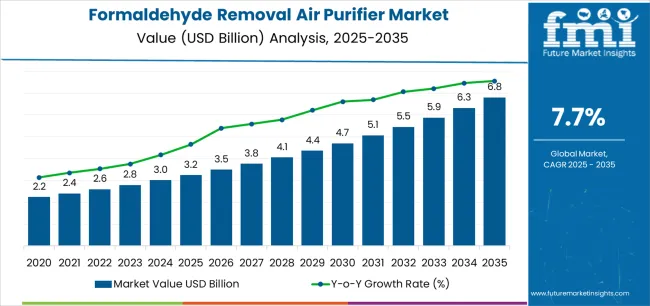
Between 2025 and 2030, the formaldehyde removal air purifier market is projected to expand from USD 3,242.7 million to USD 4,698.8 million, resulting in a value increase of USD 1,456.1 million, which represents 40.8% of the total forecast growth for the decade. This phase of development will be shaped by increasing consumer awareness of indoor air quality hazards, rising adoption of smart home technologies, and growing availability of advanced filtration systems across residential applications and commercial air quality management facilities.
Between 2030 and 2035, the market is forecast to grow from USD 4,698.8 million to USD 6,808.7 million, adding another USD 2,109.9 million, which constitutes 59.2% of the overall ten-year expansion. This period is expected to be characterized by the advancement of IoT-enabled air quality monitoring systems, the development of energy-efficient purification technologies for large-scale applications, and the expansion of automated indoor air management systems across diverse commercial and industrial applications. The growing emphasis on health-conscious living and preventive healthcare will drive demand for advanced formaldehyde removal varieties with enhanced detection capabilities, improved filtration efficiency characteristics, and superior real-time monitoring performance profiles.
| Metric | Value |
|---|---|
| Estimated Value in (2025E) | USD 3,242.7 million |
| Forecast Value in (2035F) | USD 6,808.7 million |
| Forecast CAGR (2025 to 2035) | 7.7% |
From 2030 to 2035, the market is forecast to grow from USD 4,698.8 million to USD 6,808.7 million, adding another USD 2,109.9 million, which constitutes 59.2% of the overall ten-year expansion. This period is expected to be characterized by the advancement of artificial intelligence integration in air quality management, the integration of predictive maintenance systems for optimal filter replacement scheduling, and the development of specialized purification chambers for high-concentration formaldehyde environments. The growing emphasis on proactive health management and environmental wellness will drive demand for premium varieties with enhanced real-time analytics capabilities, improved mobile connectivity options, and superior automated operation characteristics.
Between 2020 and 2024, the formaldehyde removal air purifier market experienced robust growth, driven by increasing awareness of new construction formaldehyde emissions and growing recognition of specialized purification systems' effectiveness in supporting healthy indoor environments across residential facilities and commercial air quality management services. The market developed as users recognized the potential for targeted formaldehyde removal solutions to deliver health protection advantages while meeting modern requirements for comprehensive air quality monitoring and reliable purification performance. Technological advancement in molecular filtration processes and air quality sensor systems began emphasizing the critical importance of maintaining detection accuracy while extending filter service life and improving user satisfaction across diverse indoor air purification applications.
Market expansion is being supported by the increasing global awareness of formaldehyde health risks and the corresponding shift toward high-performance specialized air purifiers that can provide superior formaldehyde elimination characteristics while meeting user requirements for comprehensive air quality management and cost-effective indoor environment solutions. Modern consumers are increasingly focused on incorporating air purification systems that can enhance indoor health protection while satisfying demands for consistent, precisely monitored air quality and optimized energy consumption practices. Formaldehyde removal air purifiers' proven ability to deliver targeted purification excellence, indoor air quality improvement, and diverse application possibilities makes them essential components for health-conscious consumers and quality-focused indoor environment professionals.
The growing emphasis on preventive healthcare and indoor environmental optimization is driving demand for high-performance formaldehyde removal systems that can support distinctive health outcomes and comprehensive air quality management across new construction projects, renovation applications, and premium residential developments. User preference for air purification that combines functional excellence with health protection is creating opportunities for innovative implementations in both traditional and emerging indoor air quality applications. The rising influence of smart home automation and advanced sensor technologies is also contributing to increased adoption of specialized formaldehyde removal solutions that can provide authentic health benefits and reliable air quality monitoring characteristics.
The market is segmented by type, application, capacity, filtration technology, and region. By type, the market is divided into filter-type air purifier, electrostatic air purifier, photocatalyst air purifier, and water-washable air purifier. Based on application, the market is categorized into household, commercial, healthcare facilities, educational institutions, and others. By capacity, the market includes small room capacity, medium room capacity, large room capacity, and whole house capacity. By filtration technology, the market encompasses activated carbon filtration, HEPA filtration, photocatalytic oxidation, and hybrid filtration systems. Regionally, the market is divided into North America, Europe, Asia Pacific, Latin America, Middle East & Africa, and other regions.
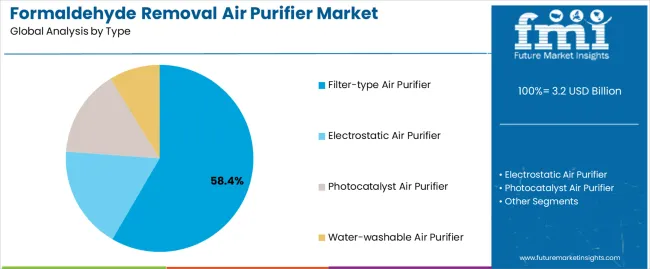
The filter-type air purifier segment is projected to account for 58.4% of the formaldehyde removal air purifier market in 2025, reaffirming its position as the leading type category. Consumers and air quality professionals increasingly utilize filter-type systems for their superior formaldehyde absorption characteristics, established performance standards, and essential functionality in diverse indoor applications across multiple building types. Filter-type purifiers' proven performance characteristics and established cost-effectiveness directly address user requirements for reliable formaldehyde removal and optimal air quality precision in residential and commercial applications.
This type segment forms the foundation of modern formaldehyde removal performance patterns, as it represents the technology category with the greatest filtration efficiency potential and established compatibility across multiple air quality management systems. Consumer investments in advanced filtration technology and performance optimization continue to strengthen adoption among health-conscious users. With consumers prioritizing air quality consistency and purification reliability, filter-type systems align with both health objectives and performance requirements, making them the central component of comprehensive indoor air quality strategies.
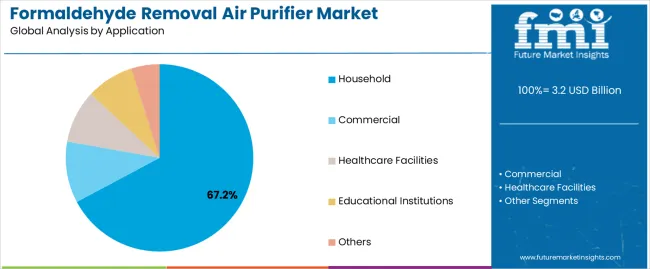
Household is projected to represent 67.2% of the formaldehyde removal air purifier market in 2025, underscoring its critical role as the primary application for health-focused consumers seeking superior indoor air quality benefits and enhanced residential environment management credentials. Residential users and homeowners prefer household applications for their established health protection requirements, proven consumer demand, and ability to maintain exceptional air quality while supporting versatile room coverage during diverse daily living activities. Positioned as essential applications for health-conscious homeowners, household offerings provide both wellness excellence and family protection advantages.
The segment is supported by continuous improvement in home automation technology and the widespread availability of established air quality standards that enable health assurance and premium positioning at the consumer level. Additionally, residential users are optimizing air purifier selections to support room-specific applications and comprehensive home air quality strategies. As smart home technology continues to advance and consumers seek efficient health protection methods, household applications will continue to drive market growth while supporting family wellness and indoor environmental quality strategies.
The formaldehyde removal air purifier market is advancing rapidly due to increasing health awareness regarding formaldehyde exposure and growing need for specialized air purification solutions that emphasize superior removal performance across residential segments and commercial applications. The market faces challenges, including competition from general air purification technologies, consumer education requirements, and initial investment cost considerations affecting adoption rates. Innovation in smart sensor integration and advanced filtration materials continues to influence market development and expansion patterns.
The growing adoption of formaldehyde removal air purifiers with smart home connectivity and Internet of Things integration is enabling consumers to develop air quality management strategies that provide distinctive monitoring benefits while commanding automated operation and enhanced real-time data analysis characteristics. IoT applications provide superior control consistency while allowing more sophisticated air quality optimization features across various residential categories. Users are increasingly recognizing the operational advantages of smart connectivity positioning for comprehensive air quality outcomes and technology-integrated home environment management.
Modern formaldehyde removal air purifier manufacturers are incorporating advanced detection sensors, real-time monitoring capabilities, and automated alert systems to enhance air quality precision, improve health protection effectiveness, and meet consumer demands for intelligent air quality management solutions. These systems improve operational effectiveness while enabling new applications, including continuous air quality monitoring programs and predictive maintenance protocols. Advanced detection integration also allows consumers to support proactive health protection positioning and performance assurance beyond traditional air purification operations.
| Metric | Insight |
|---|---|
| Infrastructure Investment ≠ Immediate SHM Uptake | Similar to infrastructure projects, large-scale investments in drilling operations often prioritize immediate output over advanced monitoring systems. Many projects allocate minimal budgets to liquid level monitoring, delaying procurement until later maintenance phases. |
| Adoption Depends on Regulatory Compliance and Industry Standards | The adoption of liquid level monitoring remains optional unless mandated by safety regulations or industry standards. In regions without binding regulations or strong enforcement, operators hesitate to implement continuous monitoring solutions. |
| Technology Readiness Gap Across Regions | Advanced regions like North America and Western Europe lead in integrating liquid level monitoring due to strong digital ecosystems. Emerging markets like Africa and Southeast Asia face infrastructure gaps and lack of technical skills, slowing adoption. |
| Lifecycle Economics Over Single-Year Growth | Drilling equipment contracts span multiple years, including installation, calibration, and maintenance cycles. Market revenues reflect long-term project timelines with fluctuating spending rather than consistent annual growth, especially in early adoption stages. |
| Hardware-Centric Perception Limits Value Realization | Operators view monitoring systems primarily as hardware investments, overlooking long-term benefits from data analytics and real-time insights. The future growth of the market is expected to shift toward "intelligence-as-a-service" rather than just hardware upgrades. |
| Procurement Complexity and Vendor Fragmentation | The decision-making process involves multiple stakeholders (oil and gas companies, contractors, safety consultants), leading to complex procurement cycles. This fragmentation can delay the adoption of liquid level monitoring systems, even in high-growth markets. |
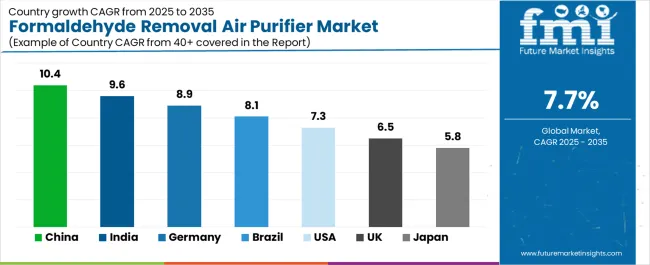
| Country | CAGR (2025-2035) |
|---|---|
| China | 10.4% |
| India | 9.6% |
| Germany | 8.9% |
| Brazil | 8.1% |
| USA | 7.3% |
| UK | 6.5% |
| Japan | 5.8% |
The formaldehyde removal air purifier market is experiencing robust growth globally, with China leading at a 10.4% CAGR through 2035, driven by the expanding construction industry, growing health awareness requirements, and increasing adoption of advanced air purification systems. India follows at 9.6%, supported by rising urbanization, expanding middle-class consumer base, and growing acceptance of health protection technologies. Germany shows growth at 8.9%, emphasizing established environmental standards and comprehensive air quality technology development. Brazil records 8.1%, focusing on urban development and health consciousness growth. The USA demonstrates 7.3% growth, prioritizing advanced air purification technologies and health optimization.
The report covers an in-depth analysis of 40+ countries, with top-performing countries highlighted below.
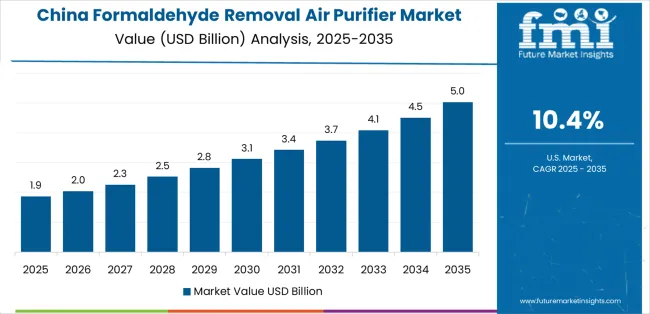
Revenue from formaldehyde removal air purifier consumption and sales in China is projected to exhibit exceptional growth with a CAGR of 10.4% through 2035, driven by the country's rapidly expanding construction sector, favorable government policies toward indoor air quality improvement, and initiatives promoting health-conscious living technologies across major urban regions. China's position as a leading manufacturing hub and increasing focus on environmental health systems are creating substantial demand for high-quality formaldehyde removal air purifiers in both domestic and export markets. Major appliance companies and air quality distributors are establishing comprehensive purification capabilities to serve growing demand and emerging health consciousness opportunities.
Demand for formaldehyde removal air purifier products in India is expanding at a CAGR of 9.6%, supported by rising urbanization investment, growing health consciousness, and expanding appliance distributor capabilities. The country's developing urban infrastructure and increasing consumer investment in health protection technologies are driving demand for formaldehyde removal air purifiers across both traditional and modern residential applications. International appliance companies and domestic distributors are establishing comprehensive operational networks to address growing market demand for health protection devices and efficient air quality solutions.
Revenue from formaldehyde removal air purifier products in Germany is projected to grow at a CAGR of 8.9% through 2035, supported by the country's mature environmental standards, established air quality regulations, and leadership in environmental technology. Germany's sophisticated building standards and strong support for advanced environmental systems are creating steady demand for both traditional and innovative formaldehyde removal varieties. Leading appliance manufacturers and specialty distributors are establishing comprehensive operational strategies to serve both domestic markets and growing export opportunities.
Demand for formaldehyde removal air purifier products in Brazil is anticipated to expand at a CAGR of 8.1% through 2035, driven by the country's emphasis on urban development, health consciousness growth, and growing appliance distributor capabilities. Brazilian consumers and residential users consistently seek health-focused appliances that enhance indoor air quality and support wellness excellence for both traditional and modern residential applications. The country's position as a Latin American consumer market leader continues to drive innovation in specialized air purification applications and consumer health protection standards.
Revenue from formaldehyde removal air purifier products in the USA is projected to grow at a CAGR of 7.3% through 2035, supported by the country's emphasis on health technology advancement, indoor air quality optimization, and advanced automation integration requiring efficient air purification solutions. American consumers and health-conscious users prioritize performance reliability and health protection precision, making specialized formaldehyde removal air purifiers essential components for both traditional and modern residential air quality applications. The country's comprehensive health technology leadership and advancing wellness patterns support continued market expansion.
Demand for formaldehyde removal air purifier products in the UK is projected to grow at a CAGR of 6.5% through 2035, supported by established health protection standards, mature consumer markets, and emphasis on air quality reliability across residential and commercial sectors. British consumers and health-conscious professionals prioritize quality performance and health consistency, creating steady demand for premium air purification solutions. The country's comprehensive market maturity and established health protection practices support continued development in specialized applications.
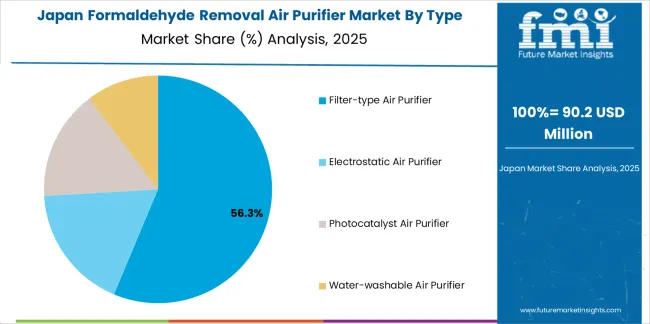
Revenue from formaldehyde removal air purifier products in Japan is projected to grow at a CAGR of 5.8% through 2035, supported by the country's emphasis on precision manufacturing, health excellence, and advanced technology integration requiring efficient air purification solutions. Japanese consumers and health-focused users prioritize technical performance and manufacturing precision, making specialized formaldehyde removal air purifiers essential components for both traditional and modern residential air quality applications. The country's comprehensive health leadership and advancing wellness patterns support continued market expansion.
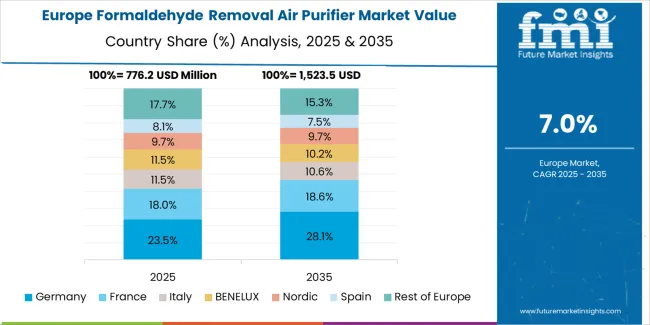
The Europe formaldehyde removal air purifier market is projected to grow from USD 956.5 million in 2025 to USD 1,847.3 million by 2035, recording a CAGR of 6.8% over the forecast period. Germany leads the region with a 41.7% share in 2025, moderating slightly to 40.9% by 2035, supported by its strong environmental regulations and demand for premium, technologically advanced air purification solutions. The United Kingdom follows with 24.3% in 2025, easing to 23.8% by 2035, driven by a mature health-conscious consumer market and emphasis on indoor air quality reliability and environmental performance. France accounts for 15.8% in 2025, rising to 16.4% by 2035, reflecting steady adoption of health protection technologies and wellness enhancement. Italy holds 9.2% in 2025, expanding to 10.1% by 2035 as health consciousness and specialty wellness applications grow. Spain contributes 5.1% in 2025, growing to 5.6% by 2035, supported by expanding urban development and health awareness modernization. The Nordic countries rise from 2.8% in 2025 to 3.0% by 2035 on the back of strong environmental consciousness and advanced health protection methodologies. BENELUX remains at 1.1% share across both 2025 and 2035, reflecting mature, health-focused consumer markets.
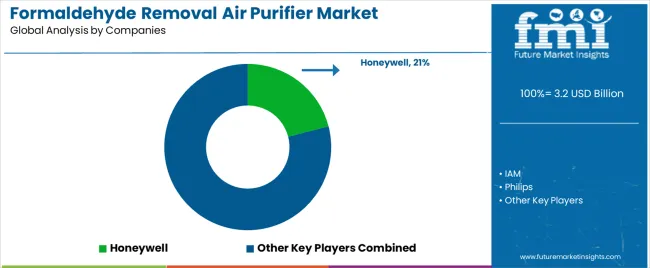
The formaldehyde removal air purifier market is characterized by competition among established appliance manufacturers, specialized air purification companies, and integrated health technology providers. Companies are investing in advanced sensor technologies, specialized filtration systems, product innovation capabilities, and comprehensive distribution networks to deliver consistent, high-quality, and reliable formaldehyde removal air purification systems. Innovation in detection accuracy, filtration efficiency optimization, and health-focused product development is central to strengthening market position and customer satisfaction.
Honeywell leads the market with 21% share with a strong focus on health technology innovation and comprehensive formaldehyde removal air purification solutions, offering residential and commercial systems with emphasis on performance excellence and technological heritage. IAM provides specialized air purification with a focus on Asian market applications and precision engineering networks. Philips delivers integrated health technology solutions with a focus on consumer positioning and wellness efficiency. Panasonic specializes in comprehensive home appliance systems with an emphasis on health protection applications. SoleusAir focuses on comprehensive residential air quality with advanced design and premium positioning capabilities.
The success of formaldehyde removal air purifiers in meeting consumer health demands, residential air quality requirements, and wellness integration will not only enhance indoor health outcomes but also strengthen global health technology manufacturing capabilities. It will consolidate emerging regions' positions as hubs for efficient health appliance production and align advanced economies with comprehensive wellness systems. This calls for a concerted effort by all stakeholders -- governments, industry bodies, manufacturers, distributors, and investors. Each can be a crucial enabler in preparing the market for its next phase of growth.
How Governments Could Spur Local Production and Adoption?
How Industry Bodies Could Support Market Development?
How Distributors and Health Industry Players Could Strengthen the Ecosystem?
How Manufacturers Could Navigate the Shift?
| Items | Values |
|---|---|
| Quantitative Units (2025) | USD 3,242.7 million |
| Type | Filter-type Air Purifier, Electrostatic Air Purifier, Photocatalyst Air Purifier, Water-washable Air Purifier |
| Application | Household, Commercial, Healthcare Facilities, Educational Institutions, Others |
| Capacity | Small Room Capacity, Medium Room Capacity, Large Room Capacity, Whole House Capacity |
| Filtration Technology | Activated Carbon Filtration, HEPA Filtration, Photocatalytic Oxidation, Hybrid Filtration Systems |
| Regions Covered | North America, Europe, Asia Pacific, Latin America, Middle East & Africa, Other Regions |
| Countries Covered | China, India, Germany, Brazil, United States, United Kingdom, Japan, and 40+ countries |
| Key Companies Profiled | Honeywell, IAM, Philips, Panasonic, SoleusAir, and other leading formaldehyde removal air purifier companies |
| Additional Attributes | Dollar sales by type, application, capacity, filtration technology, and region; regional demand trends, competitive landscape, technological advancements in air purification engineering, precision detection initiatives, health protection enhancement programs, and premium product development strategies |
The global formaldehyde removal air purifier market is estimated to be valued at USD 3.2 billion in 2025.
The market size for the formaldehyde removal air purifier market is projected to reach USD 6.8 billion by 2035.
The formaldehyde removal air purifier market is expected to grow at a 7.7% CAGR between 2025 and 2035.
The key product types in formaldehyde removal air purifier market are filter-type air purifier , electrostatic air purifier, photocatalyst air purifier and water-washable air purifier.
In terms of application, household segment to command 67.2% share in the formaldehyde removal air purifier market in 2025.






Full Research Suite comprises of:
Market outlook & trends analysis
Interviews & case studies
Strategic recommendations
Vendor profiles & capabilities analysis
5-year forecasts
8 regions and 60+ country-level data splits
Market segment data splits
12 months of continuous data updates
DELIVERED AS:
PDF EXCEL ONLINE
Formaldehyde-Free Resin Market Growth & Demand 2025 to 2035
Paraformaldehyde Market Size and Share Forecast Outlook 2025 to 2035
Urea Formaldehyde Market Size and Share Forecast Outlook 2025 to 2035
Melamine Formaldehyde (MF) Market Size and Share Forecast Outlook 2025 to 2035
Alkylation Melamine-Formaldehyde Resin for Coating Market Size and Share Forecast Outlook 2025 to 2035
Sulfonated Melamine Formaldehyde Market
Removal Strips Market Size and Share Forecast Outlook 2025 to 2035
Hair Removal Wax Pen Market Size and Share Forecast Outlook 2025 to 2035
Hair Removal Spray Market
Metal Removal Fluids Market Size and Share Forecast Outlook 2025 to 2035
Tattoo Removal Laser Market Size and Share Forecast Outlook 2025 to 2035
Earwax Removal Market Analysis by Product, Age Group, Distribution Channel, and Region Forecast Through 2035
Tattoo Removal Patch Market
Ear Wax Removal Products Market Size and Share Forecast Outlook 2025 to 2035
Laser Hair Removal Devices Market Analysis - Growth & Forecast 2025 to 2035
Stretch Mark Removal Products Market Insights - Growth & Forecast 2025 to 2035
Dental Crown Removal Market Insights - Trends & Growth Forecast 2025 to 2035
Depilatory Hair Removal Creams Market Analysis - Size and Share Forecast Outlook 2025 to 2035
Tonsil And Adenoid Removal Products Market Size and Share Forecast Outlook 2025 to 2035
Extracorporeal CO2 Removal Devices Market Size and Share Forecast Outlook 2025 to 2035

Thank you!
You will receive an email from our Business Development Manager. Please be sure to check your SPAM/JUNK folder too.
Chat With
MaRIA